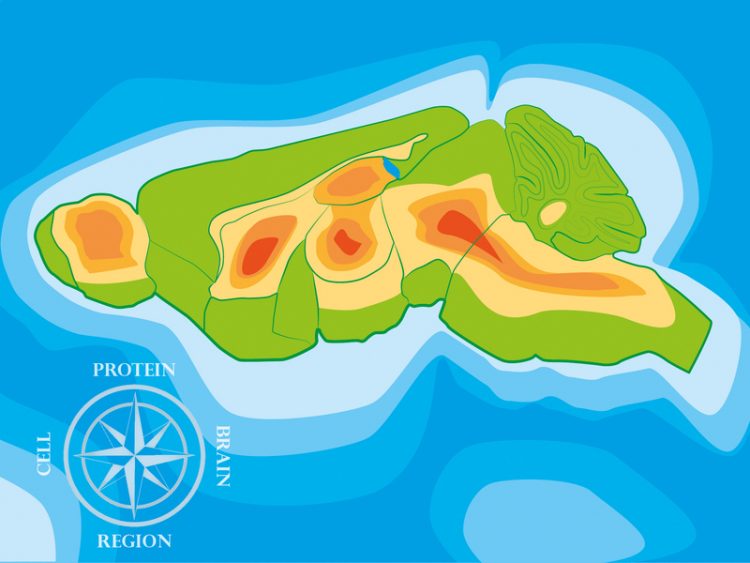A protein atlas of the brain

What looks like an island is actually a schematic representation of a mouse brain. Researchers have now analyzed the mouse brain proteome and summarized the data in an atlas. © MPI of Biochemistry/ K. Scharma
Just as in the Middle Ages when there were still many uncharted areas on Earth, researchers today are aware that there is still a great deal to learn about cells in our microcosm. But instead of sextants and compasses, researchers nowadays use modern methods such as mass spectrometry to look into the world of protein molecules.
Neuroscientists are focussed particularly on resolving brain complexity with its billions of specialized cells. To understand the brain’s functions, scientists from the Max Planck Institutes of Biochemistry in Martinsried and Experimental Medicine in Göttingen have for the first time quantified the entire set of proteins ‒ the proteome ‒ in the adult mouse brain. The information about which proteins and how many of them are found in the various cell types and regions has been summarized in a protein atlas.
The brain consists of hundreds of billions of interconnected cells which communicate with one another. Different cell types specialize in different functions. Nerve cells transmit and process stimuli from outside; distinct glial cells supply them with nutrients, regulate the flow of blood in the brain, help in isolating nerve fibres and perform tasks in the immune system.
Cells are comprised of proteins which are the functional building blocks. They act as small molecular machines and give the cell its structure. The information for synthesis of protein molecules is encoded in DNA and RNA; biomolecules which have been extensively examined in the brain.
“Up to now, however, it was not known which and how many proteins are produced in the different, highly specialized cells or even how the numbers of proteins in the individual regions differ”, explains neuroscientist Mikael Simons. “To examine this, we needed modern measuring and analysis methods in order to be able to record and evaluate these enormous numbers of proteins.”
Together with protein research specialists, a team headed by Matthias Mann in Martinsried, the scientists further developed the mass spectrometry technology for in-depth profiling of brain proteins in a rapid, reproducible and a quantitative fashion.
They were able to show that there are around 13,000 different proteins in the adult mouse brain. The quantity of proteins in the different cell types and brain regions, and how they differ from one another can now be found in the recently established protein atlas at www.mousebrainproteome.com. The protein data presented there from five different cell types and ten regions in the mouse brain constitute the most comprehensive collection to date.
This deep proteome investigation should serve as a rich resource for analyses of brain development and function. “Surprisingly, only 10 per cent of all proteins are cell type-specific”, explains Kirti Sharma, lead author of the study. “These cell-specific proteins are mostly found on the surface of the cell.”
The large majority – 90 per cent of all proteins – are found in all cell types. As in a satellite view of previously uncharted landscapes, the researchers have created a protein atlas based on the most comprehensive data collection that should help in the development of new treatments for alleviating brain diseases.
Contact
Dr. Christiane Menzfeld
Max Planck Institute of Biochemistry, Martinsried
Phone: +49 89 8578-2824
Fax: +49 89 8578-3777
Email: menzfeld@biochem.mpg.de
Prof. Dr. Matthias Mann
Max Planck Institute of Biochemistry, Martinsried
Phone: +49 89 8578-2557
Fax: +49 89 8578-2219
Email: mmann@biochem.mpg.de
Original publication
K. Sharma, S. Schmitt, C. G. Bergner, S. Tyanova, N. Kannaiyan, N. Manrique-Hoyos, K. Kongi, L. Cantuti, U.K. Hanisch, M.A. Philips, M.J. Rossner, M. Mann & M. Simons
Cell type- and brain region-resolved mouse brain proteome.
Nature Neuroscience, November 2015 DOI: 10.1038/nn.4160
Media Contact
More Information:
https://www.mpg.de/9724954/protein-atlas-brainAll latest news from the category: Life Sciences and Chemistry
Articles and reports from the Life Sciences and chemistry area deal with applied and basic research into modern biology, chemistry and human medicine.
Valuable information can be found on a range of life sciences fields including bacteriology, biochemistry, bionics, bioinformatics, biophysics, biotechnology, genetics, geobotany, human biology, marine biology, microbiology, molecular biology, cellular biology, zoology, bioinorganic chemistry, microchemistry and environmental chemistry.
Newest articles

Innovative vortex beam technology
…unleashes ultra-secure, high-capacity data transmission. Scientists have developed a breakthrough optical technology that could dramatically enhance the capacity and security of data transmission (Fig. 1). By utilizing a new type…

Tiny dancers: Scientists synchronise bacterial motion
Researchers at TU Delft have discovered that E. coli bacteria can synchronise their movements, creating order in seemingly random biological systems. By trapping individual bacteria in micro-engineered circular cavities and…

Primary investigation on ram-rotor detonation engine
Detonation is a supersonic combustion wave, characterized by a shock wave driven by the energy release from closely coupled chemical reactions. It is a typical form of pressure gain combustion,…



